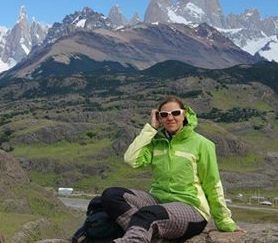
Geri on one of her field trips.
This week we caught up with Gergana Georgieva, an early career seismologist working at the Department of Meteorology and Geophysics, Sofia University. Gergana is an assistant professor, and a board member of the Bulgarian Geophysical Society. The team she is working in from Bulgarian Academy of Sciences and Sofia University has recently been awarded funding from the Science Research Fund of the Bulgarian Ministry of Education and Science to set up a seismic station in Antartica. Geri shares her experience with us.
On 19th December last year the first Bulgarian Antarctic broadband seismic station (LIVV) was installed, within the 24th National Antarctic campaign on the Livingston Island, South Shetland Islands. Station is located 1 km far from Bulgarian Antarctic Base “St. Kliment Ohridski” and close to the head of Perunika glacier. It is a temporary station and is going to be operational until the end of February 2016 (the end of the 24th Antarctic campaign).

The team heading off to Antarctica. Photo taken Iglika Trifonova.
LIVV seismic station consists of two seismometers – a broadband Guralp CMG 40-T and short-period geophone, which was originally taken as back up but was eventually also installed at the site. Data acquisition system is RefTek 130. The location of the seismic station was specially selected to avoid the noise produced by generators and the life in the Base. We achieved very low anthropogenic noise level and all recorded events have natural origin. The first results of the implementation of the project were about 265 events registered by the seismic station for the period 19.12.2015 to 25.12.2015. The events were of different sources such as earthquakes, ice shocks (earthquakes in the glacier) and collapse of ice. These were distinguished at the first review of the records.
The events were of different sources such as earthquakes, ice shocks (earthquakes in the glacier) and collapse of ice. These were distinguished at the first review of the records.

Setting up the station. Photo taken by Bozhil Vasilev.
The installation is a part of a contract DFNI I02/11/2014 “Creating an information base for study of seismicity and Earth’s structure on Livingston Island and surroundings through complex research in the Bulgarian Antarctic Base area”, financed by the Science Research Fund to Bulgarian Ministry of Education and Science. Another task of the project is studying the movement of glacier Perunika with GNSS measurements. Data from permanent GNSS station are going to be publically shared through the world’s GNSS data bank.
We are now looking forward for the last group to the return from Livingston Island, who will bring us more data.
More information and pictures can be found on: http://www.bai-bg.net/projects.html
